CHARTER SCHOOLS IN BOONE COUNTY?
47 AN INSIDE LOOK AT THE JEFFERSON MIDDLE SCHOOL ZOO

A Day in the Life
Go behind the scenes of a typical day for a local elementary school principal.


CHARTER SCHOOLS IN BOONE COUNTY?
47 AN INSIDE LOOK AT THE JEFFERSON MIDDLE SCHOOL ZOO

Go behind the scenes of a typical day for a local elementary school principal.

JOIN US ON FRIDAY, OCTOBER 25TH
AT 7 O'CLOCK IN THE EVENING AT THE ATRIUM ON TENTH for a night of elegance, socialization, and charm with the ladies & lords of Columbia and mid-Missouri as we are once again transported to the enchanting world of Bridgerton at the Second Annual Bridgerton Ball .
This event is curated in true Bridgerton fashion, from the aesthetic and food to the live entertainment. Guests will take part in a night of regency put on by The COMO 411 and their trusted friends. Regency era attire and masquerade masks are strongly recommended. All ticket holders will enjoy access to complimentary food from Eclipse Catering, a unique photo exhibit, special live music from The Missouri Symphony (MOSY), a performance by Mareck Center for Dance company members and so much more.
Limited number of themed VIP tables for 10 are available. Please email Allie Teagarden for more info at partnership@como411.com

**As a Noble and ticket holder to this benefit, please also consider yourself a patron of the arts. A portion of ticket proceeds will go to Mareck Center for Dance and MOSY.
A genuine and heartfelt THANK YOU to our most wonderful royal partners, sponsors and vendors!







Gifting to family in the following ways may decrease your gift and estate tax liability by lowering the value of your estate or using the lifetime estate and gift tax exemption.
1. Annual gift exclusion
For tax year 2024, the IRS allows individuals to gift up to $18,000 tax-free to as many recipients as the donor wants, and married couples can give up to $36,000 without triggering a taxable gift.
Donors can coordinate annual gifts to achieve estate planning objectives like potentially decreasing their estate tax liability by lowering the value of their estate.
2. Accelerated gifting with 529 plans
By making an accelerated gift to a qualified tuition program (QTP) like a 529 plan, you can contribute up to five times the annual exclusion ($90,000 for individuals and $180,000 for married couples in 2024) in a single year tax-free.
The investment earnings are not taxed while in the account and no tax
is due for distributions if they are used to pay for qualified education expenses.
3. Lifetime estate and gift tax exemption
The 2024 federal lifetime estate and gift tax exemption amount is $13.61 million for individuals and is effectively doubled to $27.22 million for married couples.
The total value of one’s estate plus any taxable gifts can be transferred without incurring federal estate or gift taxes up to that amount. Unless further legislation is passed, this exemption amount may be reduced in 2026 when the current Tax Cuts and Jobs Act (TCJA) estate tax provisions sunset, so using the lifetime exemption now may lower your eventual estate tax liability.
The medical expense exclusion is another way to give a gift to family members by paying for their medical expenses without triggering a taxable gift. The payment must be made directly to the care provider and be
solely used for qualifying medical expenses as defined by the IRS.
Gifts that qualify for the educational expense exclusion are not subject to the gift tax. The gift must be paid directly to a qualifying educational institution and exclusively used for tuition.
Gift strategically with Commerce Trust
If you are considering gifting assets to your family, consider seeking the guidance of experienced professionals to ensure you leverage the estate planning benefits available to you.
Contact Commerce Trust today to learn more about how our estate planning, trust administration, and tax management* professionals collaborate to execute a customized plan that is unique to you.

MANAGEMENT
Erica Pefferman, President Erica@comocompanies.com
EDITORIA L
Publisher | Erica Pefferman Erica@comocompanies.com
Editor | Jodie Jackson Jr Jodie@comocompanies.com
Associate Editor | Kelsey Winkeljohn Kelsey@comocompanies.com
DESIGN
Creative Director | Kate Morrow Kate@comocompanies.com
Senior Designer | Jordan Watts Jordan@comocompanies.com
MARKETING
Director of Web Services J. J. Carlson JJ@comocompanies.com


Marketing Representative Sarah Hempelmann Shempelmann@comocompanies.com
Marketing Representative Becky Roberts Becky@comocompanies.com
CONTRIBUTING PHOTOGRAPHERS
Keith Borgmeyer, Charles Bruce III

MARKETING
Director of Sales | Charles Bruce Charles@comocompanies.com
OUR MISSION
To inspire, educate, and entertain the citizens of Columbia with quality, relevant content that reflects Columbia’s business environment, lifestyle, and community spirit.
CONTACT
The COMO Companies 404 Portland, Columbia, MO 65201 (573) 499-1830 | comomag.com @wearecomomag
SUBSCRIPTIONS
Magazines are $5.95 an issue. Subscription rate is $54 for 12 issues for one year or $89 for 24 issues for two years. Subscribe at comomag.com or by phone.
CONTRIBUTING WRITERS
Beth Bramstedt, Barbara Buffaloe, Lori Galaske, Andrew Grabau, Lydia Graves, Mary Kate Hafner, Jodie Jackson Jr, Sarah Joplin, Hoss Koetting, Roger McKinney, Erica Pefferman, McKenna Stumph, Michelle Terhune


Ihave a very unpopular opinion within our current societal norms. I think it’s a disservice to families and children to schedule them in too many activities. A day doesn’t go by when I don’t talk to a mom or dad who isn’t a slave to their kids’ schedules. ey are busy, rushed, and often have a haze of anxiety that just envelopes them. ese days, it feels like kids’ schedules are busier than ever. From sports practices and piano lessons to robotics club and tutoring sessions, many kids are running from one activity to the next with barely a moment to catch their breath. While it’s great that parents want to give their children every opportunity to learn and grow, overscheduling them with too many activities can actually do more harm than good. e pressure to keep up with an overloaded calendar can a ect their mental health, physical well-being, and even their ability to just be kids. First, let’s talk about the mental load. Kids today are often juggling school, homework, and a jam-packed schedule of extracurriculars. When every hour is lled with structured activities, there’s little time left for downtime, creativity, or just plain fun. is can lead to burnout, stress, and anxiety—feelings no child should have to deal with. Kids need unstructured time to daydream, explore, and gure out who they are. When their days are too tightly packed, they miss out on these crucial opportunities for self-discovery.
en there’s the physical toll. For kids heavily involved in sports, overscheduling can lead to overuse injuries. Young bodies are still growing and pushing them too hard without enough rest can result in problems that last a lifetime. In a quick Google search, you’ll nd that the rate of sports related surgeries for children between the ages of 14 and 18 have risen dramatically over the last 10 years…some saying as high as 148%. And it’s not just sports— constantly being “on” with any activity, whether it’s dance, music, or academics, can wear kids down. ey need a
balance between active pursuits and time to rest and recharge.
Overscheduling also has a big impact on family life. When everyone’s calendar is packed, quality family time often takes a backseat. Instead of enjoying relaxed dinners, spontaneous outings, or just hanging out together, families are racing from one event to the next. is can strain relationships and make it harder for parents and kids to connect. Plus, when kids are constantly busy, they miss out on other important experiences—like making friends outside of their usual circles or simply enjoying the freedom of an unscheduled afternoon.
So what’s the alternative? It’s about nding a balance that works for your family. Take a step back and evaluate which activities truly add value and joy to your child’s life, and which ones might be more about keeping up with the Joneses. It’s okay to cut back and prioritize downtime, play, and family time.
When I was in the thick of raising my ve children through this season, I had a “one activity at a time per kid” rule. Yes, my little princes and princesses had to make some hard choices. Even limiting it to that didn’t save our family from eating many fast food meals in the minivan in ballpark parking lot.

If you’re feeling overwhelmed by your family’s hectic schedule, I highly recommend checking out Patrick Lencioni’s book e ree Big Questions for a Frantic Family. It’s a great resource for parents who want to step o the treadmill of overscheduling and create a more meaningful, connected family life. e book o ers practical advice on how to focus on what really matters and bring a sense of calm back to your home. I found it extremely helpful to nd the focus and sanity in an otherwise almost impossible situation. I hope you like it!

ERICA PEFFERMAN PUBLISHER erica@comocompanies.com
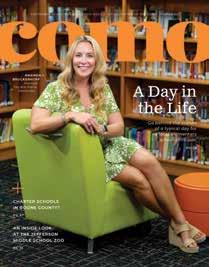
We take pride in representing our community well and we couldn’t do what we do without our COMO Magazine advisory board. Thank You!





Beth Bramstedt
Church Life Pastor Christian Fellowship Church


Heather Brown
Strategic Partnership Officer Harry S Truman VA Hospital

Nickie Davis
Executive Director The District, Downtown CID

Sam Fleury
Assistant Vice President
Strategic Communications, Columbia College

Jeremiah Hunter
Assistant Police Chief
Commander Investigations Bureau Columbia Police Department
Chris Horn
Sr. Reinsurance Manager American Family Insurance

Kris Husted
Investigative Editor NPR Midwest Newsroom
Amanda Jacobs Owner Jacobs Property Management
Megan Steen
Chief Operating Officer, Central Region Burrell Behavioral Health
Nathan Todd
Business Services Specialist First State Community Bank
Wende Wagner
Director of Resource Development
The Boys and Girls Club of the Columbia Area
Have a story idea, feedback, or a general inquiry? Email Jodie@comocompanies.com.


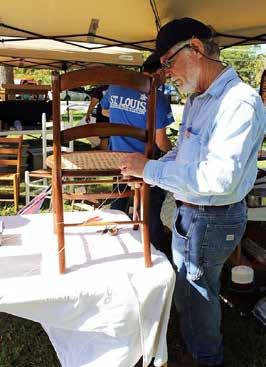




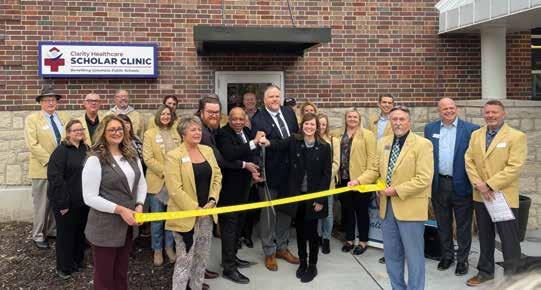
BY M C KENNA STUMPH
Clarity Healthcare’s school-based clinics help provide wider access to health care, and that’s one of the goals of the Scholar Clinic for Columbia Public School students. e clinic, housed at the CPS Gifted Center, certainly lacks the aura of a classroom. e examination rooms are decorated with bright, colorful artwork embellished with paper garlands.
“We can do everything that a primary care o ce does,” says Megan Kruse, a Certi ed Pediatric Nurse Practitioner (CPNP) at the clinic. “We can do primary care, sick visits, hearing and vision screens, vaccines, and labs ... Anything they can get done at a primary care o ce, we can do here.”
e Scholar Clinic is a Federally Qualied Healthcare Center (FQHC), focused on serving parts of the community that have di culty accessing health care. Services are provided at no out-of-pocket costs to students who receive free or reduced lunch.
Jake Rettke, program director, explained how the process works.
“We’ll work with families to make sure that if they’re eligible, we can get an ap-
plication in for Medicaid,” he said. e Scholar Clinic o ers a sliding fee scale to make sure cost is not a barrier. e clinic also o ers sports physicals at no cost to any CPS student.
e Scholar Clinic had its genesis at a Columbia Chamber of Commerce event when Matt Gas, president of the Central Region of Brightli — part of the Clarity system — had a conversation with CPS Superintendent Dr. Brian Yearwood about obstacles students sometimes encounter when they try to get health care. Students new to the country are most likely to face those challenges, and since the school setting is also among the rst social interactions for those students, it made sense to deliver health care in that setting.
“Another big component here is our translation services,” Rettke said. “We serve a huge community of individuals in which their rst language isn’t English. Having access to that resource on hand makes it a lot easier, especially when we start to break down the next steps in the treatment. We have those translation services to walk the families through what that looks like, as opposed to being dumped into a big, confusing system and having to gure that out on their own.”
Any student enrolled in the public school system can call the clinic to schedule an appointment and they will be in-
formed of whether the clinic has same-day availability or not. However, most of the time the schedule is open for sameday appointments. Most of the appointments are referrals by school nurses who call to set up an appointment for a sick child. For students who already have a primary care provider, it becomes a collaborative e ort between the primary care doctor, the parents, and the clinic, keeping an open line of communication among the three.
“A lot of our referrals come from school nurses,” Kruse said. “ e school nurses are there on a day-to-day basis and get to know the students, their families, and their resources for health care. Oftentimes they suggest for students to come to the scholar clinic if they’re having trouble being seen by their primary care doctor or don’t have one.”
Rettke stressed that parents are kept in the know.
“We’re not going to start seeing the kid until we have consent from the parents,” he added. “We want to, whenever possible, have the parents be a part of that appointment however they can. If it’s attending the appointment, be brought in on a Zoom or phone call, or ll them in after the appointment if they’re too busy.”
e clinic expects to see even more students now that vision services are o ered. is summer was the clinic’s rst project in optometry.
“ e achievement that I think the district takes a lot of pride in — I know I do — is that since opening, no more than 10 percent of the students seen by our health care providers are sent home,” Rettke said. “Even with the ones that do go home, it’s nice to know they have what they need to feel better and get back to school the next day.”













BY SARAH JOPLIN
Seventy-seven years of creativity spanning multiple generations. at’s the ongoing legacy of the Columbia Weavers and Spinners Guild.
“ ere is a fundamental human drive to take things into our hands and make them into something else,” says Nancy Elliott, the guild’s marketing director. “For eons, there has been a strong feeling among humans to go beyond just what’s necessary and instead get into how to make things more decorative or to look di erent.”
e organization that began in 1947 was founded strictly by weavers who juried prospective members to ensure that their ability met the caliber of their standards. Over the years, the guild has grown and evolved to embrace many hand crafts including spinning, knitting, crocheting, felting, and paper making with its sole purpose to increase public awareness and enhance appreciation for all aspects of ber arts.
Today, ber enthusiasts of all ages and experience levels are welcomed as members. Elliott explained that the group of approximately seventy members is growing.
“ ese days there seem to be a lot of people really interested in spinning and weaving and we’re getting younger members and new
be solitary pursuits, the Columbia guild provides a social and collaborative framework. Members have numerous bene ts and activities where they can learn, teach, or share their work.
A basic annual membership fee is $35 and includes all meetings, special study groups, a monthly newsletter, participation in the Heritage Festival, and the annual Holiday Exhibition and Sale in November.
At monthly meetings, the Weavers and Spinners’ Guild hosts speakers or presenters to cover all members’ crafts and interests. is year, the guild added gatherings it calls “ e Fifth Saturday.” ese events, which take place during the months that have ve Saturdays, last four hours and are open to the public so that the community can see what the group does, while a ording members an intimate forum to demonstrate their particular skills. One such Saturday involved a demonstration of traditional Japanese embroidery called Sashiko, used for the decorative or functional reinforcement of cloth or clothing. Skilled members also have the opportunity to share their craft by demonstrating at Columbia’s Annual Heritage Festival and Craft Show.
For years, the guild has facilitated the

students who are doing ber arts to submit work for an exhibit and chance to win awards.
“Another really wonderful component of the guild is study groups for people who want to focus on one area or craft,” Elliott said. “ ese groups provide a chance to get ideas and feedback and watch each other working hands-on in a smaller group size.”
e Columbia Weavers and Spinners' Guild Annual Holiday Exhibition and Sale will be held at the American Legion Hall at 3669 Legion Lane — o East Broadway/ Highway WW — on Friday and Saturday, November 15-16. Friday hours will be 10 a.m. to 6 p.m. and Saturday will be 10 a.m. to 3 p.m. Only juried items that uphold the guild’s long-standing quality standards will be included for sale.
“We focus on the idea of o ering the community nely crafted, hand-made items either for their home, or for clothing or jewelry,” Elliott said. e sale will also feature ber arts demonstrations. “If you’re not someone familiar with crafting or working with your hands in some way, it can seem a little bit like magic.”
COLUMBIA WEAVERS AND SPINNERS' GUILD
cwsgcomo.org cwsgcomo@gmail.com


BY LORI GALASKE
While “adventure” gives o an Indiana Jones-type vibe — high energy, high danger — “science” conjures visions of a studious individual in a lab coat surrounded by Bunsen burners and test tubes.
Columbia’s Je erson Middle School (JMS) has married these two apparent opposites and lined the halls of its science wing with a zoo. Before your imagination takes you o to a Jumanji-esque scenario with animals stampeding through the halls, these animals are in cages and aquariums. At least, that’s where they are until the students arrive.
Mike and Jen Szydlowski, science teachers at JMS, like many science teachers, brought in eggs and an incubator. When they observed their students with the eggs, the idea of a zoo hatched, along with the chicks.
Catherine Sadowski, a JMS science teacher who partners with Jen Szydlowski, says, “ ey [the Szydlowski’s] did the research and realized that having animals in the school is a really good way for students to learn how to care for things.”
A guinea pig in the JMS Zoo might wake from a pleasant night’s sleep, blink its blurry little eyes, and hear the rst of many of that day’s footsteps. is early hour is full — so many little humans want to hold it and start their day with a furry cuddle. After this early morning rush comes a lull until animal science class. is is party time when the animals get a lot of love.
“( e students) will pet them and bring them hay. ey’ll feed them produce on their desk,” Sadowski said. “ e animals are just kind of chill. ey’ll wear the snakes as little crowns, put them around their necks as necklaces, and they’ll wrap them around their wrist and carry it as a purse. ey’ll stick them in their pockets, and (the snakes) crawl into the girls’ hair.”
To become one of the four zookeepers, a student must apply and receive recommendations from other teachers. Sadowski explained, “We look at all that information and determine who would be a best t.”
A zookeeper immediately sets to work when animal science class begins. Two are responsible for preparing the animals’ food. e other two are “in the zoo” to direct their classmates in feeding the animals, cleaning cages, shredding paper (for the bird, hamster, and guinea pigs), watering plants, sweeping, and even cleaning walls.
“ ey love doing it because it’s all part of the zoo,” Sadowski added. “ ey’re phenomenal.”
What has become evident is that these animals do more than teach responsibility. ey also melt social barriers.
“It’s amazing, though, the way that they interact with each other,” Sadowski said. “Groups of friends that wouldn’t normally interact with each other nd a connection with each other through the animals. It’s hard to explain. It’s so peaceful. Eighth graders teach the sixth graders in a way that they would never do outside the hallway. When they have an animal in their hands, it’s just a whole different level of maturity.”
According to the Missouri Department of Conservation, Missouri is home to a wide variety of fauna, and the JMS Zoo has but a fraction of these natives. Sadowski hopes to change that.
“We want to do more place-based animals,” she explains. “Every year we think about different animals but de nitely want to incorporate Missouri natives.”
Most of the animals go home with students during summer break, but with the start of a new school year comes a new adventure — for animals and humans alike.
ANIMAL SPECIES IN MISSOURI
Aquatic Invertebrates (>1,000)
Amphibians (43)
Birds (390)
Butterflies/Moths (561)
Fish (200)
Insects (1,337)
Reptiles (75)
Wild Mammals (70)
DID ZOO KNOW?
The first zoo was in Hierakonpolis, Egypt, circa 3500 BCE.
Philadelphia established the first zoo in the U.S. in 1874.
The first zoo in Missouri was opened in 1910 in St. Louis.
Today the St. Louis Zoo is home to more than 16,000 animals.
Sources: Missouri Department of Conservation website; insectidentification.org


BY BARBARA BUFFALOE
As we look toward the future of Columbia, Missouri, it is imperative that we prioritize education at all levels. Education is not just a pathway to personal success; it is the cornerstone of a vibrant, thriving community. From early childhood education to public school funding, and continuing education for adults, investing in learning opportunities ensures that our city remains competitive, innovative, and inclusive.
Early childhood education is where the journey begins. Research consistently shows that the rst few years of life are critical for cognitive, social, and emotional development. In Columbia, we have made signi cant strides in supporting early childhood education through initiatives like Columbia Public School’s Early Learning programs and Central Missouri Community Action’s Head Start programs. Like with most things, there is always more to be done. Expanding access to a ordable, high-quality early childhood education is essential.
I was thankful to see in his FY25 budget, Governor Parson increased child care subsidy rates and continued funding pre-kindergarten for all 4-year-olds who are eligible for free and reduced lunch.
As children grow, the need for robust public school funding becomes paramount. Public schools are the heart of our community, serving not only as educational institutions but also as centers for socialization, extracurricular activities, and community engagement. Adequate funding ensures that our schools can provide high-quality education, attract and retain talented teachers, and maintain facilities that are safe and conducive to learning.

Columbia has a strong public school system. I urge our community to remember that maintaining and improving this system requires ongoing investment and public support. is includes not only funding for basic operational costs but also support for innovative programs that address the diverse needs of our student population.
Most recently the successes celebrated by our Columbia Area Career Center’s culinary arts program elevated Columbia to the mainstage when Sydney Bliss, a rising senior at Rock Bridge High School, placed rst in the SkillsUSA Baking and Pastry Arts National High School Competition.
Education does not end with high school or even college. In a rapidly changing world, continuing education is essential for personal and professional development. is includes adult education programs, vocational training, and opportunities for lifelong learning. Whether it’s acquiring new skills to advance in a career, pursuing a passion, or simply staying informed about the world, continuing education enriches our lives and strengthens our community.
In Columbia, we are fortunate to have institutions like the University of Missouri, Stephens College, Columbia College, Moberly Area Community College, and others that all o er a range of continuing education opportunities. We also bene t from places like the Excel Center and OSHER. e Excel Center, the accredited tuition-free high school operated by MERS Goodwill of Missouri, o ers many supportive services to its students to provide accessible options for learning at any stage of life.
OSHER at Mizzou is a lifelong learning program that provides a variety of noncredit classes and other educational, cultural, and social opportunities designed for individuals age 50 and over — all for the joy of learning.
Supporting continuing education requires a commitment from all sectors of our community. e Columbia City Council provided $6.6 million in ARPA funds to workforce development and support that emphasize connecting more individuals to educational opportunities. ese partnerships will enrich lives in our community long after the stimulus funds are expended. Education is a shared responsibility. It requires the collective e orts of government, educators, families, businesses, and the community at large. By prioritizing early childhood education, ensuring robust public school funding, and supporting continuing education, we are building a foundation for a prosperous and inclusive Columbia.
As mayor, I am committed to championing policies and initiatives that support education at all levels. Together, we can create a community where every individual has the opportunity to live, work, learn, and play.

Barbara Bu aloe currently is serving her rst term in o ce as the mayor of Columbia.
Embracing the truth about our identity.
BY BETH BRAMSTEDT
Ask anyone around what makes me break out in a sloppy grin or lights up my eyes these days and they won’t hesitate to answer. ey know it’s my granddaughters.
ese precious girls are just a year apart. One can now sit up on her own and is attempting to crawl. She is full of smiles and squeals. e other is walking and starting to speak in sentences. She is a bit shyer and more mischievous. Every time I’m with them, I marvel and giggle at the simplest things. e way they interact with each other or respond to new foods. eir rst reaction to the swings at the park, or how they respond so di erently to strangers.
In short, they bring me joy. So much joy!
Most of the time, unless you are raising teenagers (just kidding), we delight in children. We wonder in awe at how they see and respond to the world around them. Our hearts are full of a deep love that we often don’t understand and cannot explain.
Yet, when we think of God, and imagine how he sees us, we think the opposite. We feel like he is watching us out of the corner of his eye, ready to pounce any time we do something wrong. We imagine him shaking his nger in our face with the expectation that we should know better. We see him with a stern, disappointed face, rather than a face that is smiling out of love and delight.
Yes, that’s right. God delights in you.
He sees you with the same deep love and joy that you see your children and grandchildren. He enjoys spending time with you. He laughs when you do something silly, and he is happy to be with you each day.

e book of Ephesians tells us speci cally how God sees us.
In this book, the apostle Paul shares that God chooses us, we are adopted into his family, redeemed, forgiven by his grace, and granted an eternal inheritance. Paul wants us to see that God has lavished more blessing on us than we could ever imagine.
“God adopts us into his family and makes us his heirs,” says Marcus Warner, author and former pastor. “We are given authority, title, status, and security. We become members of the divine, royal family.”
When we decide to follow God, he no longer sees us as sinners. He sees us as saints. Saints! is becomes our identity. He puts our sin in our past and sees us through the eyes of righteousness. He is thrilled to have us in his family. We bring him joy.
You bring him joy!
Did you know that the identity center of the brain is also the brain’s joy center?
“ is is good news,” Marcus says, “because it means God designed us so that our true self is who we are when we are living with joy.”
From a scienti c perspective, joy is a high-energy reaction to a relational con-
nection. When we feel personally connected to God, for example, we feel joy. Our struggles come when we lack joy and are missing this relational connection. With God, the lack of joy invades our being when we misunderstand our identity. When we start believing that God cannot possibly love us or want to be around us, we lose focus in our true identity and buy into messages of shame and fear instead. What if you altered your view of God? What if you lived life with the freedom that comes from seeing yourself the way God sees you?
You would experience joy. A lot more joy! I want to leave you with this blessing from Numbers 6:24-26:
May the Lord bless you and protect you. May the Lord smile on you and be gracious to you. May the Lord show you his favor and give you his peace.

Beth Bramstedt is the Church Life Pastor at Christian Fellowship.









Shelter for homeless, traumatized teens focuses on safety and life skills.
BY M C KENNA STUMPH |
Acolorful, inviting mural in the split-level entry is the rst feature greeting visitors to Flourish, Columbia’s shelter for youth experiencing homelessness. e mural, a donated creation of local mural artist Adrienne Luther, resembles a koi sh pond with a variety of lily pads, bubbles, and calming colors of blue and green. e bubbles are an added touch with a distinct purpose.
“She designed it to re ect the koi sh underneath the water needing the protection of the pond — the pond symbolizing Flourish,” said Flourish Executive Director Beatrice Stewart. “When the youths are here, they have the safety and security needed to thrive. Our goal is that those living here will put their initials or special customization on the bubbles throughout the mural.”
In 2019, a team of Veterans United employees joined with a vision to positively impact the community. ey decided to focus their e orts on the homeless youth and those facing the challenges of socioeconomic barriers in Columbia. rough research and in-depth interviews, the VU team became aware of how educational opportunities aided in breaking the cycle of economic inequality, giving youths potential for a more nancially secure future.
When the core group of employees at VU wanted to start a community impact project, they considered a few avenues but ultimately landed on helping youth in the community. Flourish transitional housing was previously the Pathways Substance Abuse Treatment Center for in-patient youth. at center, however, had to close its doors, halting one housing option for homeless youth and leaving large gaps in services for them.

“ ere were a lot of discussions happening on the gaps, homelessness in youth, and a need for a shelter,” Stewart explained. “ e Rainbow House exists, but it is only a temporary emergency shelter. ere was a need for longer-term housing to help get the youths back on the right track.”
e transitional housing for youths between the ages of 16 to 25 began as a six-room home but has now expanded
to ten rooms, thanks to a basement remodel that was nished late last fall.
e four rooms on the lower level are for the youths on the independent living track. ose rooms are out tted to resemble a dorm room or an apartment with a twin-sized bed, mini-fridge, microwave, desk, dresser, and a small TV. Since the youths on the independent
living track are preparing to move into their own space, they can come and go as they please. ey still must abide by the rules; however, the remodel o ers them a space to be more self-su cient. e six rooms upstairs are for the youths on the supportive living track. Time is structured to include weekly life skills classes where a presenter talks










about things they youths should know. For example, Central Bank will make a presentation about budgeting. e Columbia Center for Urban Agriculture will teach them about planting the garden at Flourish, complete with a farmto-table activity and making dinner.
Youths at Flourish have established goals with benchmarks to help keep them on track, and sta check with them regularly to make sure they are progressing in nding employment, nding a therapist, or other needs.
e sta at Flourish is a fully trained medtech sta , capable of doling out prescription medication and handling other medical needs that require immediate intervention. e sta helps the youths with getting a job and transporting them to their appointments. Many are connected with therapists and other mental health professionals to help manage trauma they may have experienced from being homeless or due to other dangerous situations. Statistics also bear out that LGBTQ youth are especially vulnerable to homelessness due to their family con icts.
Since Flourish opened, it has served thirty-four youths for just over 6,100 bed nights.
“We have a lot of experience with LGBTQ youth,” Stewart explained. “Our sta are all trained for those situations. at is something unique about our program; we have a lot of youth exploring their gender and sexuality. We try to provide whatever services they need to help them stabilize.”
Every area of the shelter is used, with multi-purpose family rooms, o ces for sta , and even a co ee bar. “Nathan’s Corner” is named after a Veterans United employee who donated most of the furnishings and decorations as a legacy project for him. e walls in the dining room, where the sta and youths gather for family meals, are covered with bright and lively artwork, and every corner is stu ed full of colored pencils, paint, scissors, and other art supplies.
“I actually just wrote a grant trying to get a little art shed outside. Many of our youths are very creative and artistic,” Stewart added. “I want to give them a dedicated space to be able to work on their art and ability to express themselves.”











& ROOFING



By Austin and Cody
One of the most critical areas to focus on during the fall season is your roof. Fall is the ideal time to undertake roofing renovations that not only enhance the safety and efficiency of your home but also protect your investment.

The moderate temperatures and generally dry conditions in fall allow for easier installation and repair, ensuring that roofing materials adhere properly and that the work can be completed efficiently. Unlike the extreme heat of summer or the unpredictable weather of spring, fall provides a window of opportunity to address roofing issues before the arrival of winter’s harsh conditions. By scheduling roofing renovations in the fall, you can avoid the challenges of winter roofing, such as dealing with snow, ice, and freezing temperatures that can complicate and delay repairs. Moreover, taking care of your roof now ensures that it is in peak condition to handle the added weight of snow and the potential damage from ice dams, which can lead to leaks and water infiltration if your roof is compromised.
1. Roof Inspection and Repairs: The first step in any fall roofing renovation is a thorough inspection. This allows you to identify any existing damage, such as missing or damaged shingles, cracked flashing, or areas of wear and tear. Addressing these issues before winter sets in is crucial for preventing leaks and water damage, which can lead to costly repairs and potential
CO-OWNER, SALESMAN, AND DESIGNER
CODY GARCIA
CO-OWNER, SALESMAN, AND DESIGNER

structural damage. Small repairs, when caught early, can extend the lifespan of your roof and save you money in the long run.
2. Roof Replacement: If your roof is nearing the end of its lifespan or has sustained significant damage, fall is the best time to consider a full replacement. A new roof not only enhances your home’s curb appeal but also provides superior protection against the elements. Modern roofing materials are designed to be more durable, energy-efficient, and resistant to weather extremes, making them a smart investment for the future.
3. Gutter Maintenance and Installation: While gutters are often overlooked, they play a crucial role in protecting your roof and home from water damage. Fall is the time when leaves and debris can clog gutters, leading to water overflow and potential damage to your roof, siding, and foundation. Cleaning your gutters and installing gutter guards can prevent these issues and ensure that water is properly channeled away from your home. In some cases, upgrading to a more efficient gutter system may be necessary to handle the increased rainfall and snowmelt typical of winter.
Where quality meets recommendation! Columbia’s goto for exceptional remodeling and roofing services.
Trusted by the community, we turn visions into reality. Your dream space starts here!

Investing in roofing renovations during the fall is essential for safeguarding your home against the challenges of winter. A well-maintained roof not only protects your home from the elements but also improves energy efficiency by preventing heat loss. This is particularly important during the colder months when heating costs can rise significantly. By ensuring that your roof is properly insulated and free from leaks, you can reduce energy consumption and save on utility bills.
Moreover, proactive roofing maintenance and upgrades add value to your home. A new or well-maintained roof enhances your property’s overall appearance and increases its resale value. Potential buyers are more likely to be attracted to a home with a recently updated roof, knowing that it will require less maintenance and provide reliable protection for years to come.
At Heartland Homes Remodeling and Roofing, we are committed to providing top-quality roofing services that ensure your home remains secure, comfortable, and energy-efficient throughout every season. Whether you need a simple repair, a full roof replacement, or gutter maintenance, our team of experts is here to help you make the most of the fall season.
By Jaclyn Rogers Find more at aipaintingplus.com
Who doesn’t love spending part of a rainy or dreary weekend bingewatching a home improvement or DIY television show? Even if the inspiration is short-lived — you might go from, “I just have to do this, too!” to “Meh, maybe someday” — the time spent will likely leave a spark of creativity behind. Of course, once you realize the finished product is a fast-forwarded sprint through a marathon and a maze of tools, decisions, and expertise, you probably lean toward being grateful that there are people and companies that provide these services.
Indeed, painting is an art and a science that requires specialized tools and knowledge.
Today we all take choices of colors and brands of house paint for granted. You can visit your local paint store and browse countless shades and hues of virtually every color in the rainbow. Bring in a swash of fabric or any colored sample and it can be scanned to produce an amazingly close match of the color in minutes. Of course, the process was not always so simple. We like the way our friends at Franklin Painting summarize a portion of the colorful (pun intended) history of painting.
“One can just imagine the caveman agonizing over the choice between ‘fire soot’ grey and ‘bison blood’ burgundy for his cave decor. Evidence shows that

mankind decorated his living space as far back as 40,000 years ago using what could be called paint. The material was made from all-natural ingredients, too, from colored earth, soot, and organic materials mixed with animal blood and fatty oils. Recently archeologists discovered a site in South Africa that indicated that men (or women) used a yellowish-brown clay soil-based coating which may have been used like paint.”
Turn the clock and calendar ahead to about 2,000 years ago and ancient Egypt, which made painting an art and science that brightly colored walls — some covered by the sands of time for centuries —have stood the test of time and still look as vivid today as when they were painted. The Egyptians created colors by mixing oil or fat with lead, earth, animal blood, ground glass, or semiprecious stones. The palate included white, red, yellow, green, black, and blue. With those meager options and the early science that was part chemistry, part alchemy, they created intricate and elaborate paintings that illustrated their culture and history. Some of the best painting was reserved for the Egyptian
Jaclyn Rogers, sales representative at Ai Painting Plus, sees paint as more valuable than simply being an accent in a home. “We are painting joy into people’s homes,” she says. Jaclyn is certified as a Psychological Color Expert, which means she has demonstrated mastery in specifying interior paint in residential applications.
tombs, many of which are quite possibly still undiscovered by modern archaeologists.
Artists and craftsmen were once commissioned to do the painting, and the house painting profession began as early as the thirteenth century, with gilds of professional painters forming in England a hundred years later. These examples demonstrate the way societies old and new value the expertise and skill of a painter who understand that their tools, color options, and techniques are, indeed, a time-tested melding of art and science.
Now, there are thousands of paint colors to choose from to help increase the curb appeal of your home, and to create the personality and style you desire.
Ai Painting Plus shares that passion and the pursuit of the “just right” color combinations to create a lasting impression that is also both practical and affordable.
It’s important that you find an interior and external painter that brings knowledge, experience, and reliability — and a deep understanding of this vital history — for your next project. We’re ready to be that painter.
ROST LANDSCAPING
By Kelly McBride Find more at rostlandscaping.com
One of the most common questions we get is ‘What can I plant at the corner of my house to add some height?’
Planting this close to the house can be difficult because you don’t want to have large limbs hanging over your roof, or roots disrupting your foundation but don’t think your options are limited! So below, we are sharing a few ideas for some ‘under the gutter’ plants.
Weeping Redbuds:
These trees are trained to cascade and only grow down, never up. In general, they’ll get 8-10’ tall at most. The real selling point of these trees is the fantastic foliage colors and beautiful spring blooms.
Golden Falls, Flamethrower and Ruby Falls are a few of our favorites.
Dwarf Crabapples:
Varieties like the Tina and Firebird Crabapple have a short growth habit, allowing us to use it in tighter spaces than

a typical Crabapple. They grow about 6’ tall and 10’ wide with a round canopy.
April Showers Crabapple has the same beautiful spring blooms but is another cascading option. These reach about 8’ tall and 6’ wide.
Japanese Maples:
These come in many different shapes and sizes, so be sure to look up each variety, or ask us for help when picking them out. A couple options would be Mikawa Yatsubusa or Tamukeyama, but there are several more to choose from.

They are a great specimen tree that really stand out from the rest of the plantings.
Shrubs:
There are also several large shrubs that can be left to fill the space or be limbed up to transform into a small tree. Again, be sure to keep an eye
Kelly McBride grew up in Columbia just down the road from Rost Inc., and she's happy to still call Columbia home. She has a degree in plant science and landscape design from MU and was hired as Rost’s landscape maintenance manager after graduation. Her love for plants makes this job very enjoyable when assisting clients with their outdoor tasks. Outside of work, you can find her cooking, gardening, sewing, or doing other outdoor activities.
(573) 445-4465 ROSTLANDSCAPING.COM
on the size range needed. Anything in the 8-10’ range should work great. By keeping shrubs in mind, you open your landscape up to even more bloom and foliage options. Here are a few suggestions:
• Korean Spice Viburnum grows to about 8’ tall and wide and have a large fragrant bloom in early spring.
• Chaste Tree may need to be trimmed hard after each winter, but easily spring back to their full height each year. They have an amazing summer bloom that pollinators love.
• Smokebush Winecraft Black not only has a fun texture when blooming, but the foliage color is hard to complete with. These quickly reach about 8-10’ tall and wide.
The staff at Superior Garden Center would love to show you around or you can check out the Plant Finder tool on our website to help find you the perfect ‘under the gutter’ plant to prevent calling tree trimmers or foundation fixers.
By Jeremy McKenzie tintbytoalsonllc@gmail.com
Many people are familiar with window tint on automobiles; however, we chose to specialize solely on residential and commercial applications. We handle everything from large commercial projects like school districts and hospitals all the way down to a single window in a residence. By electing to only focus on architectural window tinting and not automobiles, Tint by Toalson offers superior workmanship in these settings. Window tinting reduces glare, heat and 99% of UV rays while still allowing natural light into the home. Installing window tint reduces up to 84% of the sun’s harmful rays and its effects on your home or commercial space. While this fact alone emphasizes the main benefit of window tinting, we will now examine some of the other top attributes of architectural window tinting.

the UV rays by 99% we can help protect furniture, flooring, artwork and any other possession in the home susceptible to fading or degradation.
Jeremy is a Columbia native who has lived many different places including abroad until finally making his way back home and purchasing Tint by Toalson in 2016. We continue with the small family-owned business mindset that made Toalson such a wellknown name in the Columbia community and always provide completely free estimates.

(573) 443-8468
Tintbytoalsonllc@gmail.com

Tinting your windows can drastically improve the energy efficiency of your home or business. In the summer months it reflects the heat and rejects it from coming in resulting in a much cooler home. In the winter tinted windows insulate the glass and help to retain the heat you’ve already paid for as opposed to it transferring out through the glass, leading to a warmer home.
Our products are a quick and easy way to reduce the damaging effects of the sun’s harmful UV rays. By virtually eliminating
If you have ever found yourself wearing sunglasses over the kitchen sink or squinting to see a computer screen or TV, tinting your windows is the solution. Tinted windows reduce the amount of glare that is able to penetrate through the glass. There are many different shades and darkness levels, but I normally recommend starting on the lighter end of the spectrum in common areas and darker in bedrooms.
Tinted windows can help to increase privacy in your home. While we do have tint options that are so light you can’t tell the windows are tinted, we also have “privacy” tint. I have had many people tell me they feel like they are in a fishbowl in their own home. There
are window tinting options available that will make it more difficult or nearly impossible for people to see into your home.
Many people think that tinting your windows will hinder or distort the view from the inside looking out. Tinted windows actually make it easier to see out and make everything look clear and crisp by reducing the intense glare that makes you squint. From the outside looking in we can keep the glass looking natural or we can utilize a darker tint to give the home a sleek modern look.
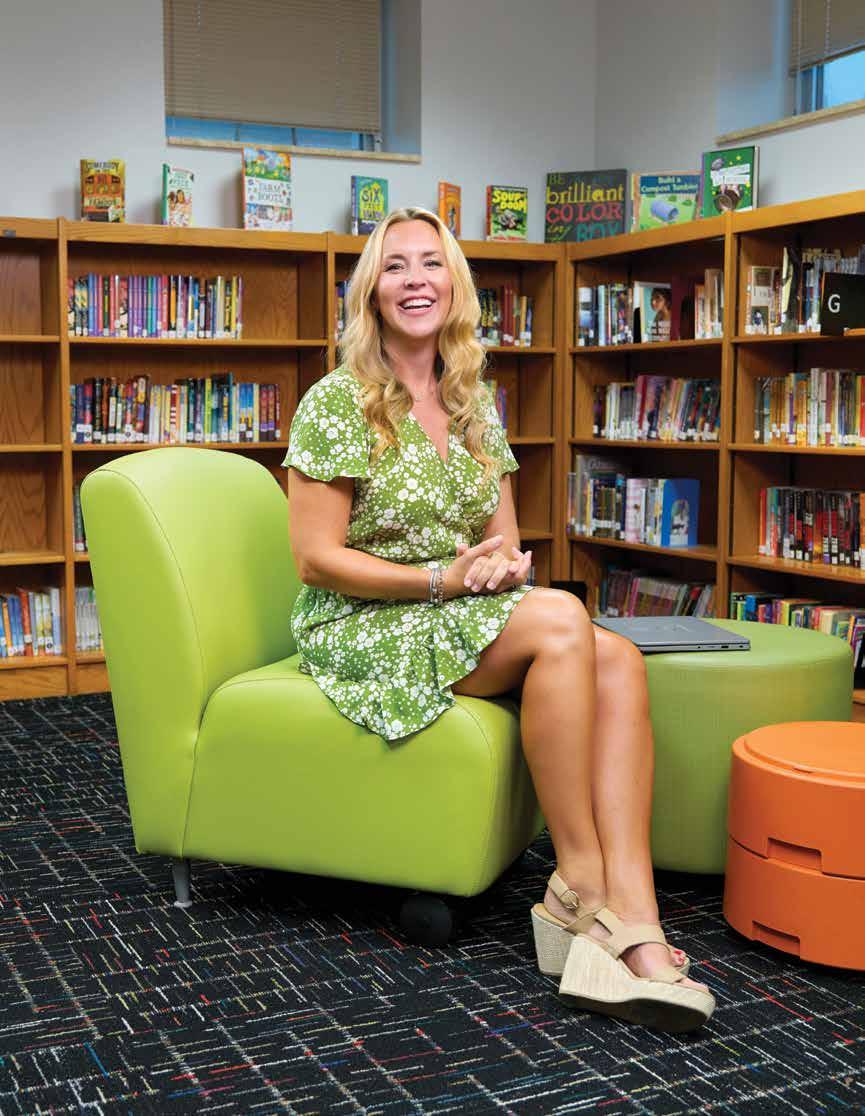
COMO Magazine’s ‘Day in the Life’ series features Columbia pros (and amateurs) who do their part to keep the globe spinning and make life fuller for the rest of us.
Amanda Bruckerhoff is the Principal at Two Mile Prairie Elementary School, which is a part of the Columbia Public School District.
Please give us a description of your responsibilities.
I wear many hats as the principal of Two Mile Prairie, especially since I don’t have an assistant principal. I support teachers with instructional practices, supervise and evaluate teachers and sta , handle all student discipline, communicate with parents and stakeholders, and maintain a safe environment. Many days I feel like I am a principal, counselor, social worker, manager, custodian, nurse, HR, and CFO. However, I absolutely love my school and feel incredibly blessed to be the principal of this sweet school community!
Tell us about your career aspirations. Did you always want to be a principal?
I always knew I wanted to be an elementary teacher but never dreamed of being a principal. However, early in my teaching career, I had a principal, Dr. Mike Schooley, who inspired me to be a better educator. He had incredibly high expectations, but through his feedback and support, I grew tremendously. Not
only did my con dence grow, but I became more e ective which led to better classroom management, higher student achievement, and a true love of teaching.
I became passionate about making a lasting impact for not only students but inspiring and supporting teachers as well. I went back to school for a degree in Educational Leadership and Policy Analysis and was excited when I was the youngest assistant principal hired in 2012 by Dr. Ed Schumacher at Russell Boulevard Elementary.
Let’s get the day started. What is your wake-up time and your morning routine?
I am not a morning person, so mornings are hard for me! I wish I could say I have a great morning routine that is healthy or inspiring, but usually, it is hitting snooze once or twice and quickly showering and drinking a cup of co ee on the road.
When does your workday start, and what are the first things on a typical daily to-do list?
During the school year, my workday starts at 7:10 a.m. at Two Mile Prairie. I touch base with our secretary and make sure there isn’t anything big that needs to be addressed before students arrive. en I usually make a second cup of co ee, chat with teachers, and make sure to check my calendar and emails before the school day begins. Doors open at 7:20 a.m. and I greet every student at drop-o . is is my favorite part of my day — the hugs, smiles, waves, and chats with our students are the perfect way to start the day.
Okay, so there might not be such a thing as a “typical day.” We imagine there are all sorts of distractions and variables. But
what, in your experience, would be a “smooth” day?
A smooth day would include great weather, so we have outside recess. (If you work in an elementary school, you know how big of a deal this is. LOL.) A smooth day would also be one where all my sta is at school or if there are absences, we have all our sub jobs lled. I would be able to go into classrooms to observe teachers, interact with students, and support teachers with minimum disruptions or emergencies.
What’s the first distraction that came your way today?
Emails, emails, emails!
Give an example or two of something that happened that made your day; something that inspired or encouraged you.
At 11 a.m. today, a teacher came in and gave me a hug thanking me for all I do for our school. She recognized the stress I have been under being understa ed and having to make di cult decisions that impact our teachers
I am so lucky to work with so many incredible people who support me, encourage me, and remind me how lucky I am to be in this leadership position — even on the hard days.
THIS is non-negotiable. You won’t be distracted from doing THIS. What is THIS?
Morning announcements. is is a priority during the school year. At 7:50 every morning, we go “live” from a classroom on Zoom for morning announcements that the whole school watches. is sets the tone for our day. It allows me to start my day in a classroom and ensures I am visible to students and sta .
My favorite part of announcements is our morning mindfulness time. We
practice breathing and calm-down strategies and gratitude practices.
Tell us about your work experience prior to becoming principal.
I was an assistant principal at Russell Boulevard Elementary School before becoming a principal. I also taught third grade at Derby Ridge Elementary and kindergarten at Rock Bridge Elementary.
What attracted you to working for the Columbia Public School System?
I am a proud graduate of CPS and am passionate about public education. I couldn’t imagine living or working anywhere besides Columbia. I plan to spend my entire career here until retirement.
If you could tell your younger self what you wish you had known or knew to look out for, what would that be?
I would tell myself that the voice inside my head telling me I am not good enough is lying. Often, imposter syndrome gets the best of me. I am proud to say at 40 years old, I feel more con dent and at peace with who I am as not only a principal, but as a colleague, community member, daughter, and friend.
So what time is lunch? What are you having?
A common misconception is that principals have a lunch break. I often chuckle when friends in the corporate world ask if I can go to a meeting or an appointment during my “lunch break.” Sometimes I have lunch walking down the hallway to get a student from class or eat while supervising them in the lunchroom.
My favorite lunch is when I have leftovers from Sunday dinner with my mom and dad!
What do your friends not understand about what you do?
e emotional toll of the job. I worry about all of my students, their families, and my sta . I am a xer by nature and always want to keep everyone happy or solve everyone’s problems. It can be very
stressful to feel like I am responsible for so many people. Many days are emotionally draining, especially if I have challenging student discipline or upset parents.
What time is your workday finished?
Although the school day is over at 2:40 p.m., principals and teachers always work after hours, on weekends, and at night.
What’s for supper/dinner? Who will you share that meal with?
My boyfriend is an excellent cook. If I have a stressful day, he will have me
over for a home cooked meal. On other evenings I enjoy recreating recipes I see on Instagram or throwing something in my air fryer.
What do you do to unwind in the evening (or earlier in the day), and what time is lights out (bedtime)?
Workout classes or long walks are my favorite way to unwind or have some “me time.” I love group tness classes at Wilson’s, Sumits Hot Yoga, and Pure Barre. I normally end the evening with a hot bath and then in bed by 10.


“Hey
Ashley! My family is attending an evening wedding in early September. Are khaki shorts with a button down shirt appropriate for my 9-year-old son to wear?”
- Unsure on the Kid Code
DEAR KID CODE:
As a mother myself, I understand the headaches involved with convincing your son to wear anything other than athletic shorts, especially when it’s hot, and don’t get me started on coats when it’s cold. However, unless the couple specifically told guests that shorts are approved attire or the wedding is being held on a beach, shorts are not an appropriate choice. Most couples will communicate the preferred dress code, but if you’re not sure, ask! Perhaps you could involve your son in a special shopping trip to pick out a cooler pair of pants and a fancy new shirt to feel his best on the big day… if all else fails, a bribe with ice cream usually works! ;)
“Hi Ashley! If you’re invited to a black tie event does that mean that you have to wear a long ball gown or does a cocktail dress work as well?” -
DEAR BLACK TIE:
Dear COMO Mag Readers,
We are back for this issue’s installment of “Ask Ashley”, where readers submit questions on topics like etiquette, navigating social norms, and blending tradition with modern trends. As a wedding and event planner, these topics are one one of the main tasks I tackle during our planning process and I take great joy in providing well thought out advice and research based opinions to my clients. This issue’s topics tackle the tricky dress code questions that our dear readers have. Keep the questions coming by emailing me or dropping them into my social media inboxes!
Black Tied-Up
This is a tricky one! If the invitation wording states “Black Tie,” a long gown is preferred. However, you may also consider a midi-length dress or a more formal cocktail dress. If the invitation wording states “Black Tie Optional”, you have a little more wiggle room for creativity. A floor length gown is still preferred but you may also consider the aforementioned options and even dressy separates. Think a dressy feminine pant suit or a classy cropped satin top with a floor length satin skirt. Either way the invitation reads, your best bet is to embrace a floor length option and choose seasonally appropriate attire. Whatever you choose, rock the confidence and have a blast!


Discover pure old-fashioned fun with your family at Silver Dollar City during Harvest Festival presented by Humana, Sep 13 - Oct 26. By day, see visiting craftsmen and cowboys as autumn blankets the Ozark Mountains and, by night, be wowed by thousands of illuminated pumpkins and larger-than-life masterpieces, thrilling rides, concerts and late-night fun for Pumpkins In The City® presented by Mercy. Treat yourself to the best fall of all at America’s #1 Theme Park...make plans today at silverdollarcity.com

The Heart of the Ozarks

BY LYDIA GRAVES
Afew months back, I came across a box full of whimsy, imagination, and — ultimately — my future. Feelings of distant nostalgia and fondness washed over my being as the box, stacked full of my childhood cookbooks, stared back at me. I had the urge to pull one out and cook something from a random page. Simultaneously, I wanted to make a day of it, picking through each book with intricate detail, examining every word, and reminiscing on bites from youth. ese special feelings were unique, yet somehow it was as if they were mirrored when I came across Samantha Dillard. e author’s story and cookbooks embody the feeling and joy of learning and the spark of creativity.

Proli c cookbook author, food writer, and digital content specialist, Samantha Dillard got her start in Missouri — both literally and metaphorically. She was born and raised in Springeld, Missouri. By 2009, she was o to Columbia — where she would later live — to pursue a college career at the University of Missouri. ere she relishes a captivating food community including favorites such as Just Je s (she mentions the seasoned cheese curds are “unlike anything around”) and Goldie’s Bagels (“ at’s the kind of place you go early to pick up break-
fast when visiting because you want to impress them,” she boasts.)
Opening her career chapter, she imagined delving into photography. Dillard notes, “Eventually, I took food photography-speci c courses which became a springboard for lots of great opportunities working with various food brands like ParmCrisps and NuTrail Granola to provide photos, video, and SEO-focused content to their websites.” However, post-grad she found herself exploring the blog scene. She explains, “[My husband and I] didn’t know how to start so we just

to algorithms. We jokingly call it the ‘golden age of blogging’ because you could make something you love and post it and it would get hits on Google and Pinterest.”
A lot of projects rose from that, but the most substantial came about in 2017. Dillard had received an email from her publishing company.
“Adams Media, an imprint of Simon and Schuster publishing, was interest-


“Ultimately I’m just focused on what value I can bring to readers each day, and I’m grateful to do that through any avenue that opens up.”
in the food world as well as her cooking knowledge.
“I’m really happy with how things are right now with my books, contract work, and position at AllRecipes,” she adds. “Ultimately I’m just focused on what value I can bring to readers each day, and I’m grateful to do that through any avenue that opens up.”

ed in an Instant Pot book for a new-ish series ‘I Love My …’ is moment seemed unreal,” she says. Since beginning the exploration of the series, she has written one to two books a year focusing on all kinds of niche subjects like air fryers, Instant Pots, three-step recipes, comfort food, and more. She is also the News Update Editor at Allrecipes.com, sharing news
Not only did the story of success nd her through college and unexpected pursuits, but Dillard also met her husband in the Mark Twain Dorm in 2009. rough the whirlwind of college, they grew closer. Two weeks after she graduated in 2013, they were married.
“I can’t talk about the journey without talking about my husband Joe, as well,” Dillard emphasizes.
“He’s the visionary. He’s the person behind the scenes keeping everything running. He’s also my biggest support when I’m feeling uninspired, or things happen like my camera falling into a bowl of soup right before a big photo deadline. We’ve both been all-in on this journey together and he’s been my encouragement and inspiration every step of the way.”
In-home life and career, the pair are almost inseparable, working well together in all aspects. e two even planted an Easter egg in Dillard’s recent works. She has taken on the pen name Robin Fields, a mash between each of their hometowns.
is is no surprise sentiment from Dillard. Despite the fondness towards her continued success, her dream and focus has always been family.
at same idea of family-orientation carries through in her body of work. e recipes keep common themes of quick, easy, budget-friendly, and crowd-pleasing. For instance, some of her newest works include a refreshing and lling three-ingredient Caesar wrap. As well, her recipe for a two-ingredient chicken bake is what they might call a “page-turner” — decadent, tender, and easy to feed a family with. Each of her recipes also acts like a teaching moment, emphasizing that cooking does not have to be di cult. She hopes that, after reading her work, people walk away understanding that they are capable of creating. Dillard continues, “It can certainly be discouraging when you rst start and there are so many resources it can be overwhelming. My goal is always to provide clear recipes that are written from an inclusive perspective so that any skill level can nd success.”
e next work in Dillard’s series is s, released August 6, 2024. e book doesn’t necessarily aim to teach cooking skills but, instead, to provide ideas on how to combine ingredients for fast meals that are also budget friendly.
“For so many students, it’s their rst time on their own and the book’s introduction covers things like how to stock your pantry for the rst time, choose the right kitchen tools, and basic food safety,” Dillard explains. “It’s a book that

I hope students and their parents will appreciate for its straightforward approach.”
It was a project inspired by her time at the University of Missouri and driven by all the shortcuts she has learned.
It's her tenth book. e I Love My… series is large and has options for any interest including keto, gluten-free, baking, and more.
“One thing that brought me a lot of joy recently was that Scholastic really liked my last book, I Love My Air Fryer Easy Recipe Book. ey were so excited that they placed a huge order and will be putting it in book fairs nationwide in the fall,” Dillard exclaims. “As a kid, you know, book fairs were everything. So to hear from my publisher that they not only placed this order but also that it will be a special edition speci cally made for Scholastic book fairs felt like such an amazing moment.”
Childhood book fairs cannot be forgotten. e excitement, the bright book covers, the trinkets, and the idea that — with each page — imagination rises. Dillard’s books have a rightful place here. Inspiring and enchanting minds far and wide. Each copy awaits someone to spy it across the room, scoop it up, and nd themselves mesmerized.
Honey Chipotle Fajitas


Read Samantha Dillard’s recipes on AllRecipes.com. Find her cookbooks at Target, Walmart, Barnes & Noble, and Sam’s Club.
Finally, Dillard also mentioned downtown Columbia’s Endwell Taverna (as featured in the July 2024 “City” issue of COMO Magazine) as a place not to miss.
“Columbia is unique because it seems there’s always something new popping up. Last week I tried Endwell Taverna’s pizza, which I’ve had my eye on for a while,” she gushes. “It was di erent from the typical pizza you’d nd in a chain, and the crust had an awesome avor.”
BY HOSS KOETTING
One of the rst stories that I recall that pertained to culinary creativity was the story of Stone Soup. is is a tale, apparently of eastern European origin, in which a hungry soldier (or soldiers, depending on which version you hear) wanders into a famished town looking for food and rest. e townsfolk, who are faring only marginally better, hide what little food they have and refuse to o er any to the stranger. e soldier, being quite resourceful, begins to make “stone soup” in a large cauldron by boiling some stones in water.

After some time, he tastes the broth and convinces one of the curious citizens to try it. ey agree that it needs something, and the local contributes an onion. Later quizzical villagers contribute all the additional ingredients that combine to make a hearty, savory potage that the entire town feasts on. ey are all amazed that such a grand soup could be created from just a few stones and beg the soldier for his secret.
His secret, of course, is that if everyone pitches in and contributes what assets they have, no matter how seemingly insigni cant, a superior result greater than the sum of the parts is achieved. As this is true in the philosophy of community and teamwork, it is also true in the culinary world. A soup, stew, potage, bisque, or chowder, if made properly, transcends all the individual ingredients to become a mélange of avors in one satisfying dish.
So how does one achieve that perfect marriage of ingredients? e starting point is a good stock. is can be a laborious and time-consuming endeavor if it is made from scratch, simmering bones, and roasted meat for hours with the proper mire poix and sachet d’epices. Or it can be accomplished using a quality soup base or broth with the main ingredient being the product it is named (i.e. “beef” as the rst ingredient in beef base or stock). e broth should be rich and avorful to complement the rest of the ingredients. e stock should then be simmered with vegetables appropriate to the recipe, generally celery, onion, carrot and/or peppers. Good quality aromatics should be used in addition to spices and freshly ground pepper. If any salt is added, I would recommend sea salt for a clean avor. Making soup is akin to an artist creating on canvas. e recipes are guidelines that can be modi ed to suit individual tastes or whims. is is the time of year to try your hand at a pot of homemade soup, as there’s nothing that warms the body and soul on a crisp fall’s day like the aroma of a favorite potage wafting through the house when you walk through the door. Here’s a relatively easy one that has a little kick.

Jim “Hoss” Koetting is a retired restaurateur/chef who enjoys gardening, good food, good bourbon, and good friends.
• 2 lbs diced cooked chicken
• 1 ½ c chopped onions
• 1 ½ c diced tomatoes
• 1 c chopped celery
• 1 c diced carrots
• ½ c chopped green peppers
• 2 tbsp minced garlic
• ¼ c minced fresh parsley leaves
• 3 qts chicken stock
• 2 tsp dried leaf thyme
• 2-3 tsp Hoss’s Cajun seasoning
• ¼ lb long grain white rice, uncooked
• Bring the stock to a boil.
• Add the onions, celery, carrots, garlic, tomato, thyme and Cajun seasoning, bring back to a boil.
• Add the rice. Reduce the heat to a simmer, uncovered, for about 15 minutes.
• Add peppers, simmer 5 more minutes or until the rice is tender.
• Add the chicken and parsley. Add more Cajun, if desired, to taste.







The Rotary Youth Exchange gives students the opportunity to study abroad. It all begins with a little matchmaking.
BY MICHELLE TERHUNE
Every year, about 10,000 high school students or recent graduates from roughly 100 countries embark on international journeys. For some, it will be the adventure of a lifetime. For others, it’s the beginning of an intrepid desire to see the world.
As Columbia students depart, international students arrive. ey’re all immersing themselves in another culture, language, and way of life. It all begins with the spark of a good match in the Rotary Youth Exchange (RYE).
RYE adheres to U.S. Department of State student exchange rules. Students must be enrolled at an accredited school during their stay. Sponsors, in this case, local Rotary clubs, must be near the students during their exchange and maintain regular communication with students and host families.
RYE is about Rotary districts worldwide, the individual clubs that comprise them, and the members of those clubs, welcoming students and host families alike.
Columbia is part of District 6080 which encompasses fty clubs with more than 3,000 members. e district RYE committee manages the exchanges with input from each club’s youth exchange o cer and counselors. It collects local student applications and forwards them to its exchange partner districts around the world. e international districts accept applications, vet host families, and decide which students stay with which three families during their exchange.
“Each exchange student participating in a ten-month exchange through Rotary has three host families for the course of that time,” says Lindsay Dorr, a RYE ocer and a member of the Columbia South Rotary Club. “ ere are several bene ts to this rotation, including that the inbound students get to experience the lifestyle of multiple host families. It also alleviates the concern for some hosts with an assigned student rather than one selected by them.”
e number of students from the district outbound to another country doesn’t necessarily match the number coming into the district. For example, this year D6080 has nine outbound students and






twelve inbound, because three clubs who don’t have outbound students are hosting inbound students.
It’s a little like putting together a puzzle. But what makes a good match, anyway?
Kit Freudenberg, district youth exchange chair, said that matching the interests of the students with clubs who can ll them is key.
“We try to match students with Rotary clubs with the local schools and activities,” she said. “For example, if the student wants to try out for a swim team, we will look for a community team or school team for that placement. Many times, we match a student who needs language help with a club which has those contacts. Or perhaps a student wants a rural experience.” ere’s not one person behind the curtain, deciding who ts best where.
e district RYE committee shares student interests with clubs who then might request to host speci c students based on their interests.
Student preferences, of course, also play a huge role in the process. Case in point is Daniel Shedd, a 2024 graduate of Rock Bridge High School High School who left Columbia in August to experience a gap year exchange in Liège, Belgium.
“I selected Belgium because I have been studying French for many years, and I was looking for a country that would give me the opportunity to use the French that I have learned,” said Shedd. “I chose Belgium speci cally because I felt like it was a country with lots to o er while still staying in the shadows of the more popular European countries like France, Germany, and Italy. Additionally, Belgium was one of the countries who accepted gap-year students like me. It was truly the perfect t for me.”
Although he has already graduated, Shedd is now attending a local high school. He met his host families before he left Columbia and looks forward to traveling with them beyond the borders of Belgium. at’s adding even more exploration to Shedd’s exchange, which is something he’s looking forward to.
“A gap year through Rotary Youth Exchange was the perfect fit for me because I love traveling, learning, and living experiences that not everyone can.”
— DANIEL SHEDD
“A gap year through Rotary Youth Exchange was the perfect t for me because I love traveling, learning, and living experiences that not everyone can,” he said. “For me speci cally, it works well because I am not entirely condent in what way I want my future to go. I have many ideas and interests, but I am not sure what I want to do when I get older. I found it a good idea to take some time, broaden my mind, live different experiences, try new things, and use that time to think about and explore what I want to do when I return.”
Families willing to host inbound students are a critical part of the match. Families undergo background checks and vetting. Sometimes, the gender of inbound students can be an issue, for example, if students will need to share a bedroom with a member of the host family. Matches may depend on factors such as allergies. For example, a student allergic to pets won’t be placed with host families who have them.
Tom and Molly Froidl previously hosted students from Spain and Brazil,
and have just welcomed another from Brazil into their home.
“We enjoy getting the know the students, showing them our city, and taking them on trips to help them see other parts of the country,” Molly Froidl said. “Each experience of hosting is di erent. It’s like any relationship. It takes commitment from all involved.”
She said challenges have come up when the students struggle to be actively involved in family and school life here because they are still engaged with their friends and family back home. It can be hard for them to nd a balance or push through the homesickness, she explained.
But the Froidls say they’re never alone, and that RYE provides a support network.
If your family needs help getting the student to or from school sometimes, or to and from activities, there are people who can help with that,” Froidl says. “If the student is struggling with homesickness, there are RYE people who can help, like the inbound counselor or youth exchange o cer.”
e Froidls met their students and their families virtually before they arrived and in person during their stay with other local host families. Moreover, they have a unique perspective on the student-host match. eir son, Drew, was a RYE student to Mexico during the 2022-23 school year. ey had no input into which district he would be sent to or which families he would stay with while he was there. But they had faith in the program.
“It ended up being a fabulous experience for him, and he really enjoyed all three of his host families,” Froidl noted. “Each family was very di erent, and he has kept in touch with all of them since he returned home.”
Based on their experience and their son’s, the Froidls o er some sound advice:
“Treat the student as a family member right away. Be exible and willing to be spontaneous. Don’t change how you do things but allow the student to opt into or out of things within reason. Encourage them to say ‘yes’ to new experiences. Help them meet people and get involved with activities.”
a new future to
BY MARY KATE HAFNER
There is a well-known saying that goes, “If you give a person a sh, they eat for a day. If you teach a person to sh, they eat for a lifetime.” But what happens if you teach a person to own the pond? To United Community Builders Executive Director Damian Dean, owning the pond can be the most signi cant di erence. Owning the pond means generations are eating sh.
Dean has lived in Columbia since 1998 and has worked with United Community Builders (UCB) since its beginnings. UCB, a faith-based not-for-pro t in Columbia, sprouted from its parent organization, United Community Cathedral, with the mission to expand community outreach beyond the four walls of the church.
UCB’s day-to-day can be seen in its mission statement, “... working to inspire and educate people to achieve in life.” Serving all community members, from pre-kindergarten students to 99-yearold neighbors, UCB has been able to help students not only stay but excel in school and uplift underemployed workforces through its varied programs. Dean said that the people UCB serves are often one skill set or helping hand away from sustainable living.
“Some of the students we served did not know that they were skilled until we kept pushing on them, loving them, and telling them that ‘You can do this,’” said Dean.
UCB’s Assistant Director of Child Development, Roshelle Watson, is a testament to Dean’s concept. Shortly after moving to Columbia, Watson was unsteady about where her life was heading. Without a support system, she was stuck and needed a hand.
“ e program was the best decision that I made because years later, I can sit here and say I am so proud of my accomplishments,” Watson said. “I feel like if I didn’t take this class, then I would not be in the position that I am now.”
During the six-week Transformation program, Watson was paired with an accountability partner who allowed her space to be her authentic self while she navigated her return to the workplace and gured out who she was again. After completing the course, Watson volunteered to help watch the children of other program participants, which eventually led to her current role. To Watson, the space to be herself and be seen without judgment was the most valuable aspect of the program.
“You know, many of us come from di erent walks of life. Some of us have it better than others. Some of us have struggled,” Watson added. “For her just to embrace me and open up made me feel at ease. I appreciated that the most because it’s very seldom that you’ll meet someone who will just be so open to sit and listen to your story.”
Soon, Northeast Columbia’s Whitegate neighborhood will be home to UCB’s latest project — e Beacon of Light Community Center, a 22,500-squarefoot crossover of recreation, education, and community space.
“When I came to Columbia, the Whitegate area was the place for college students. It was a place for young families,” Dean noted. “And over time, it went the opposite direction.”
Dean has described Whitegate as a “resource desert” for families. e neigh-

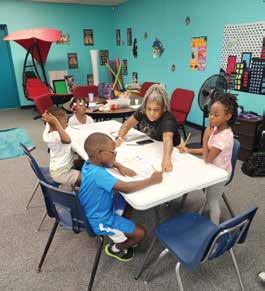




United Community Builders envisions a united community, working together to equip all low-income, at-risk, and minority children and families to rise above poverty and become successful and selfsufficient in life.
United Community inspires and educates people to achieve in life.
• Damian Dean, Executive Director
• Tim Rich, Director of Development
• Alexander Plummer, Director of Marketing
• Tawana Minor, Director of Child Development
• Roshelle Watson, Assistant Director of Child Development
• Sandy Slone, Director of Education
• Lula Nix, Early Childhood Assistant Teacher
• Linda Williams, Classroom Assistant

borhood lacks many social services within walking distance and is known for high crime and poverty rates and the low academic achievement of its kindergarten through twelfth-grade students. Additionally, a disproportionate amount of neighborhood housing is Section 8. Dean sees the project as an opportunity to provide hope to the community. e community center broke ground in September 2023. As of early August 2024, UCB had successfully raised $7.9 million, exceeding its initial goal. e fundraising has expanded phase one of construction to include only the rst oor’s gymnasium, the second oor’s after-school program, and administrative wing. Dean said the initial expansion creates enough space for UCB to grow sustainably for years.
Programs moving into the facility include the United Community School House, a before- and after-school care and daycare program; Transformation, a job skills-building program; Club Kid Connect, a summer program; Homework Hour; the Community Meal; and a food pantry. In the new space, UCB will service up to sixty-nine kids in the child development pre-K department alone. Dean anticipates increasing sta ng from ve full-time employees to about twenty over the next ve years.
“What I see is that we’re not starting a project, but we’re starting a movement,”
Dean explained. “And the movement is to restore and revitalize the Whitegate area and the ird Ward. But at the same time, be a beacon of light for the whole community. And we’re not saying it because it sounds good. at’s how we operate.”
To Watson, UCB has become her home and family, and the Beacon of Light Community Center is an immense source of pride.
“I’m really excited to see what’s out there and how we will be able to provide and give back to the community,” she said.
Some of UCB’s strengths contributing to its steady growth are its holistic approach to community support and collaboration with community partners. UCB is not interested in duplication or reinventing the wheel if another organization is already doing a program well. Some of UCB’s partners include Love Columbia and In2Action. In its future facility, UCB hopes to collaborate with Columbia Public Schools.
Dean added, “If we cannot help the whole person, then we need to gure out how to help the whole person.”
UNITED COMMUNITY BUILDERS
617 N Providence Rd (573) 449-0340 contactus@ucbuilders.org ucbuilders.org

YOU WANT ANSWERS. WE WON’T REST UNTIL YOU HAVE THEM.

There’s a place where medicine’s most difficult questions come for answers. It’s here, where our breakthrough discoveries are used all over the world. Where believing anything’s possible is how we treat every patient. And where we never settle. Neither should you.
NEVER SETTLE
Columbia Main / 1411 Grindstone Plaza Dr. / 573-442-9900 Columbia Stadium / 1215 Fellows Place / 573-815-7500 onemidwest.com



“We are so excited to announce Woodhaven was recently awarded the Neighborhood Assistance Program(NAP) tax credits from the Missouri Department Economic Development. The NAP program will enhance our work with neurodivergent youth and children, youth and adult individuals with disabilities in education, employment, and training. We are so grateful to MO DED for giving us this amazing opportunity to credit 50% back to our qualified donors and sponsors!”
DeAnna Alonso, MSW-PPA Chief Development Officer, Woodhaven Learning Center dalonso@woodhaventeam.org • 573-876-7312 Woodhaven Neighborhood Assistance Program Tax Credit Oppor tunity
Missouri’s Neighborhood Assistance Program (NAP) allows its residents to determine how their state tax dollars will be spent through their charitable donations.
This credit combines with your federal and state charitable income tax deduction to lower the net cost of your donation. The Missouri Neighborhood Assistance Act makes the NAP credit available to any person, rm or corporation with business income in the State of Missouri.
We encourage you to take advantage of these tax credits now. They will go fast!
The legislature’s massive education bill authorized expanding the alternative school model.
BY ROGER M C KINNEY



Charter schools likely are on the way to Boone County. Just not right away.
An explanation probably is in order. A charter school is like a combination of a private school and a public school district. ey’re not-for-pro t and don’t have elected school boards like traditional public schools. Charter schools don’t charge tuition. e Missouri General Assembly at the end of the 2023-24 legislative session approved expansion of charter schools into Boone County — authority that was previously only allowed in Kansas City and St. Louis. Gov. Mike Parson signed the bill.
e governor’s signature overrode the wishes of Columbia Public Schools and o cials with other Boone County school districts, who said the charter schools will further dilute the state funding available to them.
“Public education is the heart of our communities and exists to provide an education for all children,” said CPS spokeswoman Michelle Baumstark in an email. “Strong public schools mean strong, thriving communities. Public schools impact economic growth, workforce development, employment, and populations. Dismantling those structures will hurt the very fabric of our communities.
She continued: “Our children do not choose their circumstances and we, as public schools, are committed to educating them all.”
Boone County school districts would lose more than $15 million in funding if charter schools open, Baumstark said, citing an analysis by the Missouri School Boards Association.
For his part, Parson de ected criticism of his decision to sign the education bill despite requests not to.
“I’ve said all along since I’ve been governor, I don’t care how a kid gets an education, as long as they get an education,” Parson told COMO Business Times following the o cial groundbreaking of the I-70 expansion project in Columbia on June 13. “I don’t care whether it’s Christian, whether it’s charter, whether it’s public, whether it’s private. You know what? Competition’s good.”
Parson’s 5-year-old granddaughter was among the event attendees.
“What I do care about is some small child to be able to have an opportunity to have an education. I don’t care how you get there. But I want them to have that opportunity,” he explained. “If somebody’s’ doing it better than somebody else, you need to gure out why they’re doing it better than you — and gure out how to make changes.”
But local school o cials say the stakes are high, and that voters had no say in the decision.


“ is is really a funding question,” Baumstark added. “ e taxpayers, who represent the market in this question, had no say in whether charter schools should be authorized to open in Boone County.”
Baumstark pointed out that CPS taxpayers have supported the school district “many times over the years by voting to approve bond issues and tax levies to fund their public schools.” Some 60 percent of funding comes from those local sources.
“In the case of charter schools, taxpayers will pay more for a service they are not guaranteed access to — and that they didn’t vote to approve,” she added. When the district considers a funding need, it must seek permission from taxpayers, “and then must remain accountable for those funds authorized by the voter.”
She continued, “Additionally, public schools have locally elected Board of Education members that also must answer to the public. Neither of these criteria are the case with charter schools.”
Some superintendents in Boone County and adjacent districts in a letter also threatened legal action to block the measure, calling it unconstitutional because it doesn’t meet the standard of a local or special law that is supported by a rational basis, adding it “will not survive a legal challenge brought before the Missouri courts.”
Baumstark did not have any new information about potential legal action.
e e ort to bring charter schools to Boone County was spearheaded by outgoing Senate President Pro Tem Caleb Rowden, R-Columbia, who said he sees the measure as a great achievement.
“It’s a huge accomplishment for me as I leave the Legislature,” Rowden wrote in a text message to a reporter's question. “A legacy item that I will be proud to have been a part of decades from now.”
He said he has no direct connection to any charter schools in the works here and only pushed to get the bill passed. His sister, Rebekah Jouret, is elementary principal at Christian Chapel Academy, one of Columbia’s thriving private schools.
“I will be rooting for the charters to succeed from the sidelines!” Rowden wrote.
ere aren’t any immediate plans for a charter school in Boone County. e law took e ect August 28. But there are discussions taking place, said Noah Devine, executive director of the Missouri Charter Public Schools Association, a supporter and promoter of charter schools.
Devine said he can’t reveal anything about the conversations in which he has been a part.
“ ere are several folks who are interested,” he said, adding, “It will take time.”
How much time?
“ e process begins with a letter of interest rst,” Devine said. “It takes eighteen to twenty-four months from a letter of interest to a charter opening. More likely it would be the 2026-27 school year before a charter school would open in Boone County. e 2025-26 school year is possible, but not likely.”
Asked if there is a market in Boone County for charter schools, Devine pointed to a 2023 Saint Louis University/YouGov poll. Among likely voters statewide, 52 percent said they supported charter schools in their districts, 20 percent were opposed, and 28 percent weren’t sure.
Asked if charter schools should be allowed statewide, 55 percent supported, 19 percent were opposed, and 26 percent weren’t sure.
Charter schools can only take students from the public school districts where they’re located, Devine said. A charter school in Columbia Public Schools boundaries could only take students from within those boundaries.
Charter schools are not a panacea. ey have a wide range of student performance from high-performing to low-performing.
e Missouri Charter Public Schools Commission is a state o ce whose sole purpose it to sponsor charter schools. It sponsors the most charter schools of all the sponsors.
Charter schools have something that works in their favor, said Robbyn Wahby, director of the commission.
“No student is assigned to a charter school,” Wahby said. “Every family is there because they desired to be in that school.”
Sponsors establish contracts with the schools, she said.
“We hold them accountable with performance contracts,” Wahby said. “We do that accountability work each year. We make decisions whether a contract should be renewed or not renewed.”
If a contract isn’t renewed, it can be revoked, and the school may be closed.
If another sponsor isn’t performing to standard, the commission receives those schools in its portfolio.
Charter schools aren’t required to o er student transportation as public schools are, she said.
“I think there are wonderful opportunities to both parents and educators” for charter schools in Boone County, Wahby said. “We would be delighted to talk with them.”
Charter schools are presented as another option for students in public school districts that are failing. Public schools that score lower than 70 percent on the Department of Elementary and Secondary Education’s (DESE) statewide Annual Performance Review (APR) are in danger of losing their accreditation. Those d is tricts are considered “provisionally accredited” and must make and achieve a plan to restore accreditation — or else.
CPS scored just 70.1 percent on its 2023 APR, putting it on the cusp of losing its accreditation. Overall scores on standardized testing – just one among other measures of the complex scoring system – improved from 2022. District officials and Board of Education members point to other improved measures as evidence that CPS is taking steps to improve its APR score.
DESE groups school districts in three categories:
• Accredited.
• Provisional.
• Unaccredited.
As of March 2023, 511 of Missouri’s 517 school districts were accredited, and six districts are "provisionally accredited." Provisionally accredited districts are still accredited, according to DESE. But if a district becomes unaccredited, students still receive diplomas.
However, according to state law, unaccredited districts must pay tuition for students transferring to an accredited school district. Accredited school districts must accept students transferring from unaccredited districts.
Charter schools aren’t escaping the post-pandemic issue of widespread student absenteeism. e state standard is 90% of students in school 90% of the time.
Among schools in the commission’s portfolio, Brookside Charter School in Kansas City had 60.7% attendance; Atlas Public Schools in St. Louis had 63.8% attendance; and De La Salle Education Center in Kansas City had 25.9% attendance. e data is from the schools’ annual reports.
“A kid is a kid is a kid,” Wahby said of the student absenteeism.
By distinction, according to data from the Missouri Department of Elementary and Secondary Education (DESE), CPS had an attendance rate of 73.6 percent in 2023, down from 84.7 percent in 2019. at is similar to the state of Missouri as a whole, which had an attendance rate of 76.7 percent in 2023, down from 87.3 percent in 2019.
Baumstark said in April 2024 that the district is dealing with an increase in overall absenteeism since the pandemic, with more students missing more often.
Meanwhile, Wahby said that another distinction of charter schools is that families are there by choice. She also noted that charter schools trade more accountability for autonomy.
She gave the example of De La Salle, a school for students in grades nine through twelve. One group of its students are overage and under credit. Another is rst-time freshmen. It also serves students who need to make up a few credits. Simply looking at the graduation rate would not provide a true picture of its focus, Wahby said.
At Brookside, Superintendent Roger O eld works to establish connections with families, she said.
Atlas is a K-3 school that started three years ago in St. Louis, said Colby Heckendorn, executive director and co-founder. It will expand to K-5 and will o er preschool in the future.
With a 91.6 percent score on the state Annual Performance Report, it has the highest APR

“We’re all working with the same goal, to reach a high standard for our students.”
— COLBY HECKENDORN, ATLAS EXECUTIVE DIRECTOR AND CO-FOUNDER
among charter schools. However, that measure doesn’t include academic scores because no students were in grade levels that took the Missouri Assessment Program tests.
Atlas promotes itself as “Diverse by Design.”
“We wanted to design the school that would set all students up for success,” Heckendorn said. “We really pride ourselves on our sense of belonging.”
e student population is 78 percent Black, 6 percent multiracial and 14 percent white. One hundred percent qualify for free- or reduced-price meals. Seven percent are students with disabilities and homeless students make up 2.5 percent of the student population.
“It takes intentionality,” Heckendorn said. “We’re free and public and open to all. We want to make sure we serve all the students of St. Louis.”
e school operates year-round — ve weeks on and two weeks o . e rst week o is a break for
teachers. e second week is strategic planning and training for teachers.
“It has really worked well for us,” Heckendorn said.
He also explained that place-based learning is another focus for Atlas, describing that approach as “expeditionary learning” by getting students into the community beyond the four walls of the building. For instance, students study trees in the Missouri Botanical Garden. First-graders have a unit on tools and work in which they visit a nearby hardware store. e school invests in teachers, with two in every classroom, Heckendorn said.
He also suggests that some of the misgivings voiced by public school o cials about charter schools may be misplaced.
“We’re all working with the same goal, to reach a high standard for our students,” Heckendorn said. “Our kids are the ones who will bene t.”


Want to generate deep feelings of nostalgia? Scan through photos of your high school days. It’s not only the faces and smiles of old friends and acquaintances but also the setting that gives clues about the place and period in which the photos were snapped. For anyone who graduated in the twentieth century, there’s one thing missing from the setting that today’s teens would never be caught without.
Smartphones. e electronic gadgets are perhaps the most ubiquitous accessory at all levels of life these days, whether at home, work, or school.
But when Columbia Public Schools began its 2024-25 academic year on August 20, a new cell phone policy — either a ban or a restriction, depending on who you ask — was in place to separate students from their mobile phones, at least for part of the school day. e school district announced the coming policy in late spring.
Even as the new school year began, many parents reported that they still were unaware of the policy’s details and how teachers and administrators will enforce it.
rough media reports, district spokeswoman Michelle Baumstark pointed out that the district already had an established cellphone policy. e new procedures put in place ahead of the new school year are designed to improve the way the district enforces the policy — and clarify expectations about the phones and other electronic devices.
Here’s the policy and enforcement measures in a nutshell, according to communication on the CPS website:
• In high school, students will not be allowed to use their cellphones during class time. Phones must be out of sight in any classroom or “dedicated learning environment.”
• In middle school, cellphones use will not be allowed at any time during the entire school day. at means students may not use their phones during class, in the hallway, during lunch, or any other time.
“I think it will calm things down in the classrooms so the kids can learn,” said Rachel Worthington, whose son (a junior) and daughter (a senior) attend Hickman High School.
Worthington, a Columbia resident since 1994, said her daughter was at rst somewhat distraught over the cellphone policy, saying “they’re talking about taking our phones away at school.” Worthington said she tries to balance the reasons some students will be reluctant to comply with the policy with the district’s stated objective of creating a better learning environment with fewer distractions.
“My daughter said, ‘I’m not giving up my phone. What if something bad happens?’” Worthington said, adding, “I think these days kids are so concerned about an active shooter.”
Last year, she said, an incident at school created confusion and many students felt as if they were in danger. Cellphones were a link to the outside world.
“I think we all do that with our cellphones,” Worthington said, remembering that once upon a time, “We always had ways to get in touch with our parents, before we had cell phones. But it’s a di erent world now.
Worthington was still perplexed about not knowing more details or a plan to enforce the policy.
“ ere are ways other schools have done it. But I think completely banning phones at school is not feasible,” she said. “I tell my daughter that this is temporary, put your phone away, and listen to your teacher.”
How will the cellphone restriction be enforced? e school website spells that out. After the rst o ense, students will be given a verbal warning from a teacher or sta member. For subsequent o enses, phones and other personal electronic devices will be con scated and stored in the school o ce for the rest of the day. Repeat o enders may be required to have a parent or guardian retrieve their phone. e school district further explained the rationale for the policy.
“We have seen in our buildings that cellphones, earbuds, and other personal electronic devices do not often serve a
helpful academic purpose,” CPS said in a statement on its website. “We have a responsibility to respond to the growing issues of cyberbullying while also fostering healthy hallways and classrooms.”
Speci cally, the updated policy — presented as “expectations” — are designed to create a more conducive learning environment, reduce distractions, promote face-to-face interactions, and ensure “students are fully engaged in their educational activities.”
CPS is hardly a pioneer in school districts regulating cellphone use. According to the National Center for Education Statistics, more than three-quarters of K-12 schools in the country prohibit cellphone use to some degree. And, in some cases, the decision is being passed down from state legislatures. Indiana, Florida, and Ohio have passed laws requiring schools to limit or prohibit cellphones. At least a handful of other states are considering similar legislation.
“It is a distraction — kids are texting each other, watching movies, whatever they’re doing,” Worthington added. She agrees that a policy and enforcement is needed, but she isn’t sold on taking a device away from a student.
Adding another layer to the cellphone restriction or prohibition picture is the growing chorus of mental health professionals joining education administrators who are expressing concern about safety and mental health. Some have pointed to U.S. Surgeon General Dr. Vivek Murthy asking Congress to require warning labels on social media platforms that are similar to warnings that appear on tobacco products. While not directly tied to cellphone restriction policies, health and school o cials have cited cellphone and social media use as signi cant sources of bullying and social pressure.
In a June 17 opinion piece in e New York Times, Murthy said that social media is a contributing factor in the mental health crisis among young people. According to 2022 data from the Pew Research Center, up to 95 percent of youth ages 13 to 17 say they use a social media platform, and more than a third say they use social media “almost constantly.”
According to 2022 data from the Pew Research Center, up to 95 percent of youth ages 13 to 17 say they use a social media platform, and more than a third say they use social media “almost constantly.”
Whether a health warning label on social media platforms ever comes to fruition — such labels would certainly be challenged in the courts by tech companies and free speech advocates — remains to be seen. But Murthy does connect the issue to schools and parents for regulation and enforcement. He said schools and parents need to participate in providing phonefree times.
In fact, the European Union and most schools across Europe have digital rules prohibiting or restricting social media and digital devices for teens.
Meanwhile, Columbia students and their parents will learn how to navigate the new cellphone rules together.
“It’s not like you can ask kids to leave their phones at home,” Worthington said. “But, personally, I think that kids should put their phone in their bag and listen to their teacher. ere's no reason not to be respectful to the teacher.”
And that strikes another chord for a di erent conversation about cellphones and school rules. Children model their parents, Worthington said, and that modeling should be about behavior toward teachers and how to conduct yourself in the classroom.
“It’s really sad,” she explained. “When I was in school, if you talked back to your teacher, if you were disrespectful, you got sent to the principal’s o ce. I’m not sure if that still happens.”




Remodeling your home can add safety, comfort, convenience and space to what can be the most valuable asset you own. It’s important to find the right remodeler for the job.
•Search the HBAC Member Directory at c columbiahba.com
• Request assistance in finding a Member Remodeler through our 'Find A Contractor' tool at columbiahba.com
•Look on home improvement websites such as Houzz houzz.com/OrganizationMembers/nahb
•Ask friends or neighbors for referrals


Membership in HBAC Remodelers indicates a remodeler’s commitment to professional quality construction, responsible business management and reliable customer service. Members have:
• Pledged to a Code of Ethics that includes compliance with rules and regulations, fair pricing, quality workmanship and prompt timelines.
• Access to resources on the latest regulations, codes, new products and construction techniques.
• A network of local and national suppliers, subcontractors and industry experts.
• Often earned professional designations to gain advanced training and specialized knowledge, such as Certified Graduate Remodeler (CGR), Graduate Master Remodeler (GMR) and Certified Aging-in-Place Specialist (CAPS).

Kristen Warren is an integral part of our loan operations team. She always shows a willingness to help and swiftly finds a solution to
She has become a mentor and a source of knowledge to many of her coworkers. She always has a positive
and is enthusiastic about her job. 573-874-8100 • centralbank.net/boonebank

What was your senior superlative or quote? And include a senior photo!
Who doesn’t love a good throwback to glamour shots and awkward yearbook photos? Our readers and advisory board members shared a sneak peek into their glory days, and check out our staff’s throwbacks on page 4 of CBT

“Life is what happens when you’re busy making other plans.” — John Lennon (SO original) Cameron (MO) High School class of ’90.
CASSI ELLIOTT CODY

Ok, I’ll play. I was voted “most likely to be editor of Sassy Magazine,” and this was my yearbook photo.
SARAH CATLIN

Check out owner of Rho and child of the ’90s, LAURA KITZI! As she still sprinkles “rad” into her coaching now and then, we’re guessing this is how she signed yearbooks. . . Stay rad, stay true, and don’t you forget about me. BFF, Laura.
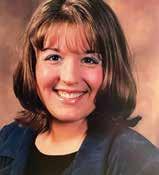

“You shouldn’t take life too seriously… you’ll never get out alive.” —

I got “best personality” for superlatives my senior year, class of 2001.
KRIS HUSTED
Serving some 2001 frosted eyeshadow realness.
#Classof2001
WENDE WAGNER

Never over-tweeze your brows!! John Hersey H.S.
MONICA WATKINS
COLLINS

Senior Tomahawk Yearbook
Editor. It was all cut and paste in the ’80s.
Join the convo online!
MICHELE PHILLIPPE
BATYE





Experience the enchanting beauty of fall in the Ozarks at Dogwood Canyon, where vibrant foliage transforms the native landscape into a tapestry of rich reds, oranges, and yellows. As you explore the scenic trails, enjoy the crisp autumn air and the serene sights and sounds of nature. Whether you’re hiking, biking, touring our wildlife pastures, or simply soaking in the views, Dogwood Canyon offers an unforgettable autumn adventure that captivates the senses and rejuvenates the spirit.
Dogwood Canyon Nature Park is proudly part of the Johnny Morris Conservation Foundation.